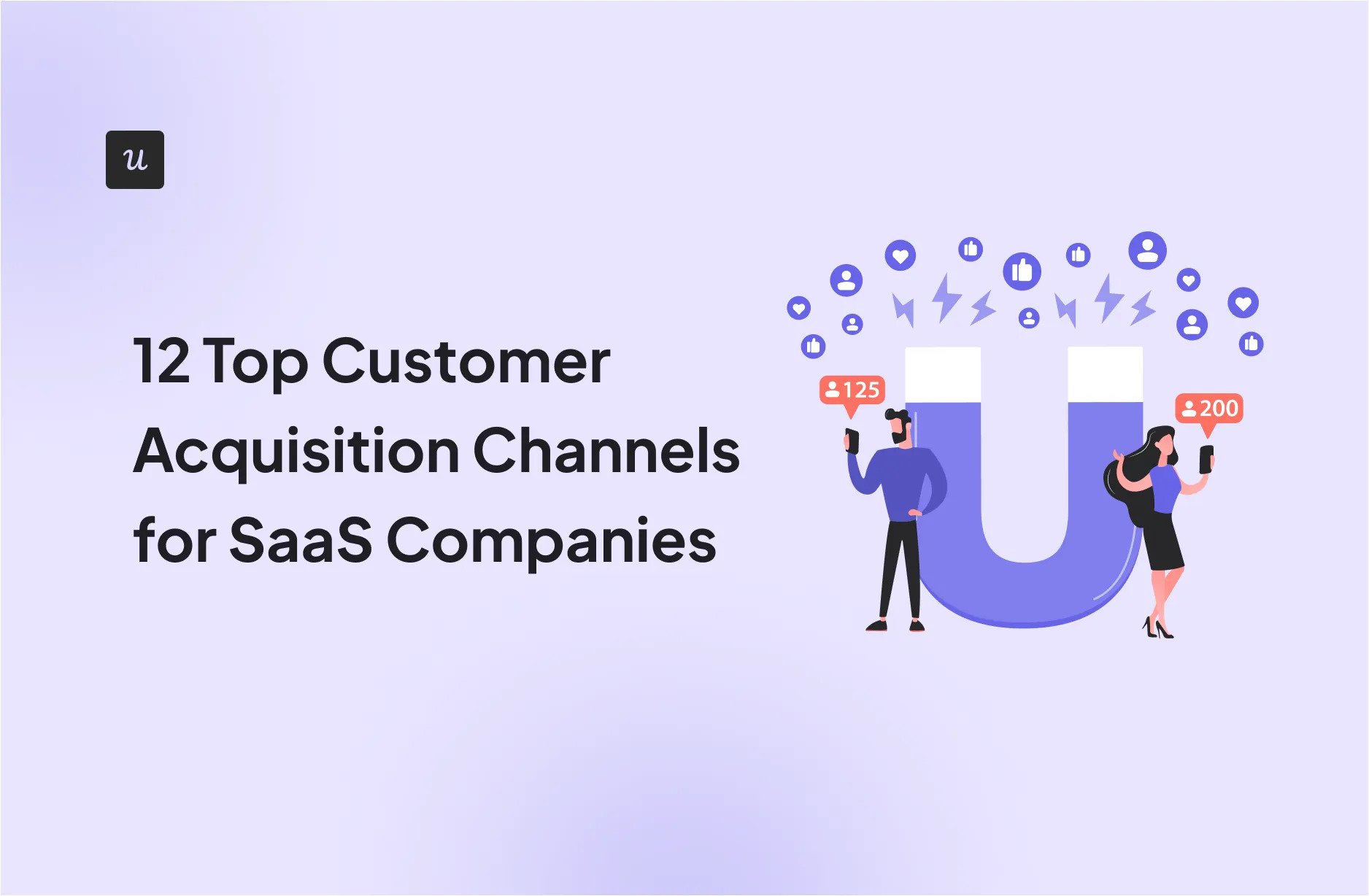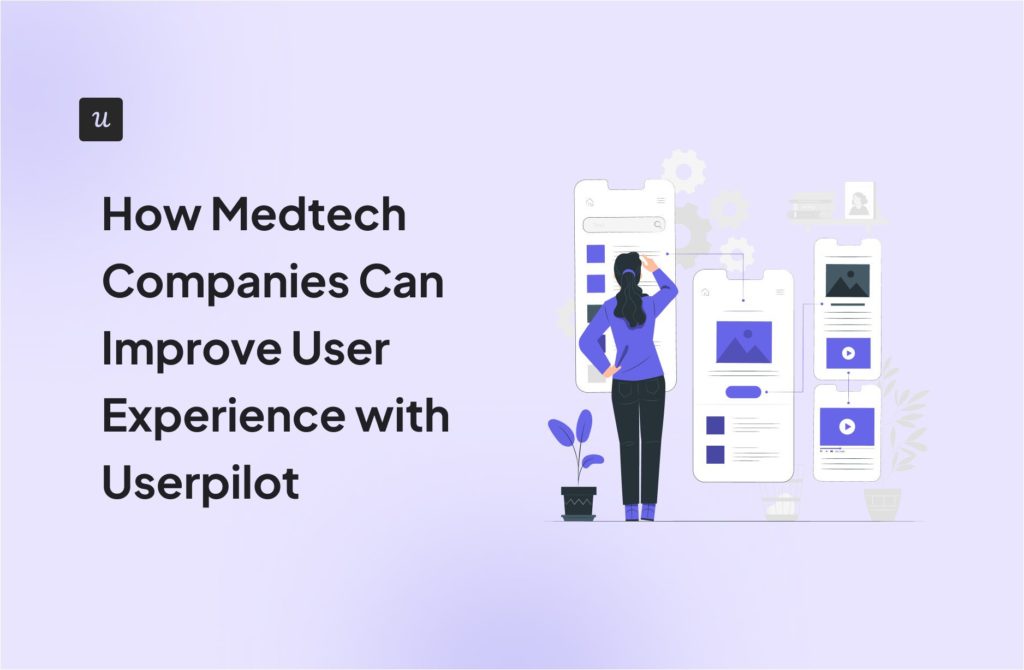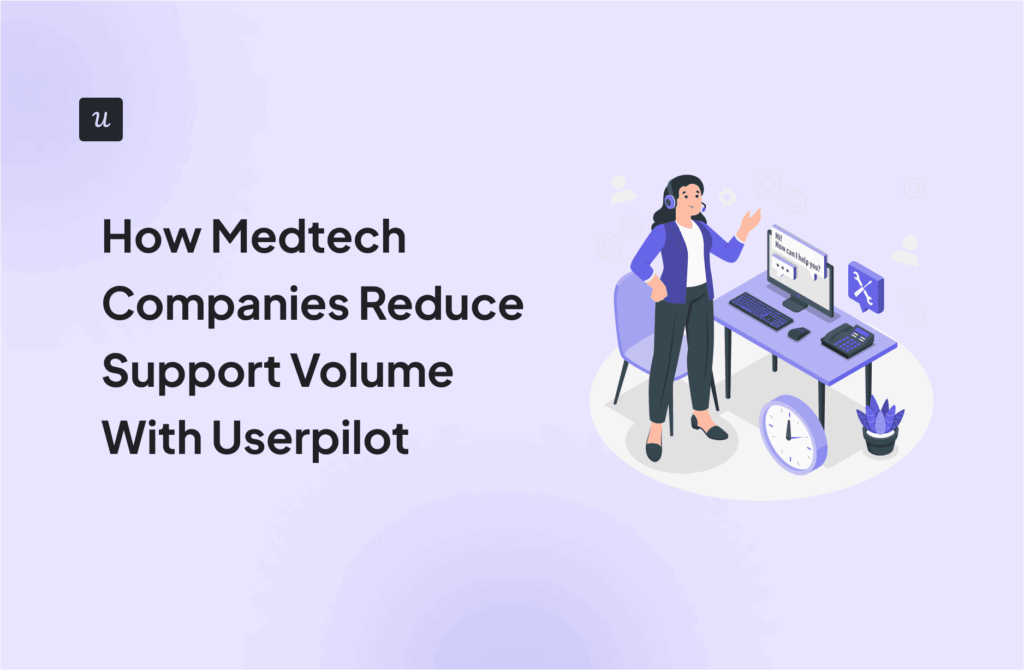
How do you ensure a smooth cash flow for your SaaS business while scaling it? The answer is customer acquisition. You need more clients who'd be happy to spend on your subscription plans. To find them, you need to tap into the right customer acquisition channels.
Let's look at the best ones that you can use to find potential customers and how to use them and product management well to scale your business.
Get The Insights!
The fastest way to learn about Product Growth, Management & Trends.
12 Best customer acquisition channels for SaaS
Each company has a distinct audience, and what fuels growth for one may fall flat for another. With that being said, we’ve compiled some of the acquisition channels that in our experience work best for software products. We’ll do a deep dive into each, hopefully helping you choose the right one for you.
1. Organic search
Figure this—Google sends a whopping 63.41% of all US web traffic to websites. Bing is the second-most popular (7.21%) source of referrals. This makes organic search a must-have for any customer acquisition strategy.
This channel involves creating content that provides value to your potential customers and attracts them to your SaaS. When such content is combined with product-led SEO (search engine optimization) best practices, it helps you rank higher in relevant searches and drives traffic to your website.
That said, your product-led content marketing efforts could take months to start showing results as it takes time to build authority and climb up the search engine rankings. However, consistent SEO efforts can help you drive long-term growth at a relatively low cost from this customer acquisition channel. Some tools you can use include Semrush and Ahrefs.
Case in point—Userpilot offers customer retention features and creates content related to churn prediction. Note how this educational blog post ranks at the top of the search results for the keyword "churn prediction."

2. Paid search advertising
The other way to drive traffic from search engines to your website is through paid-per-click (PPC) advertising. In this case, you create search engine ads and bid for each keyword you're targeting. You then have to pay for every click a potential customer makes on the search engine.
The idea is to drive traffic from the search engine to your landing page to get visitors to turn into leads or paying customers.
Unlike organic search, this method comes in handy when you want to drive a large traffic volume within a short period. All you need is the right set of keywords, a killer ad copy, and a robust ad budget.
The drawback here is that you could quickly burn through your budget and your listings would be removed once it exhausts. You can use tools like Google Keyword Planner and Microsoft Advertising for this method.
Note how Monday.com's listing here shows up under the "Sponsored" category for their target keyword.

3. Engineering as marketing
Another fantastic customer acquisition strategy, engineering as marketing, involves using your developer skills to build free tools for your target audience. Much like content marketing, the idea here is to provide greater value to your prospective customers before they consider buying from you.
The free tools you provide them can position your brand as a trustworthy and helpful source, which, in turn, can drive customers to consider buying from your SaaS business. At the same time, it delivers greater value to existing customers, helping you retain them.
For instance, HubSpot has a free website grader tool for its prospects and existing customers. This tool analyzes the customer's website and offers suggestions for improvements. In these, it provides CTAs (calls-to-action) to their core products like CMS, nudging prospects to subscribe to those tools.

4. Email marketing
Emails have been around for a long time, but they're still very effective for acquiring customers and retaining existing ones. In fact, 60% of consumers say they want brands to contact them through email.
They particularly serve as an excellent tool for lead nurturing and driving conversions. Once you've got a lead's email, you can send them helpful resources related to your SaaS and move them toward conversion.
Email marketing can work wonders if you implement contextual email campaigns. The key is to tailor your emails based on the user's current interactions with your brand and their stage in the buyer's journey.
To ace your email campaigns, write crisp and attractive subject and preview lines, make the emails mobile-friendly, and highlight the CTA well in the body. You can use tools like Mailchimp, ActiveCampaign, and MailerLite for your email campaigns.
Here's a great example from Airtable. Note how it includes a short video tour and also gives links to helpful resources but doesn't overwhelm the user with information.

5. Viral marketing
This method, much like growth loops, revolves around word-of-mouth from your audience. It harnesses the power of your existing customers to organically drive product growth until it becomes viral (shared by users at a large scale).
But to achieve product virality, you have to come up with a solid strategy. Make it easy for users to share your product with others to scale its usage. Similarly, encourage user-generated content and carefully place your branding at spots where others would notice.
Case in point—note how Calendly cleverly inserts its branding into an appointment calendar. Every time someone lands on the calendar page, they'll see the branding. Additionally, it's a freemium product and users can easily share calendar links with others. This product-led growth helped them go viral.

6. Online communities and forums
You could also use communities and forums like Appsumo, Product Hunt, and Quora to promote your SaaS and acquire customers. It's also a great way to drive your customer acquisition cost down as many of these communities are free.
Customers frequently reach out to communities on these forums with questions. You can answer those and solve their problems. Plug your SaaS products subtly into these answers to attract them to your brand.
Likewise, you can launch your SaaS on Product Hunt to give it greater visibility. Be sure to answer related questions and respond to reviews in the discussions section. It can build greater trust in your product.

7. Social media marketing
Social media is the second-largest referral traffic driver after search engines. And with over 5.04 billion users, it's a channel you shouldn't ignore.
Like search engines, you can use both organic and paid customer acquisition strategies on social media. From Instagram Reels to Stories and memes, you'll see plenty of high-ROI content all over the platform – and there are a bunch of content formats available on social media, so you can get a little creative with your marketing as well.
Even among paid ads, you get options like in-feed, carousel, videos, and Reels, among others. Alternatively, you can partner with influencers to create sponsored content on social media.
This is also a place where you can showcase your brand persona and connect with potential customers directly through messages and comments.
That said, without robust negative feedback management, you could face some PR issues. Use tools like Buffer and Hootsuite to manage your social accounts well.
Here's how Semrush uses memes to engage with their audience on LinkedIn.

8. Affiliate marketing
Another way of reining in your customer acquisition cost while driving sales is to work with affiliates. These are influencers or people who promote your SaaS products on social media or websites and get a fixed commission per sale in return.
Typically, you create a unique affiliate link for each affiliate and share it with them. It helps you track the number of sales coming in through each affiliate. The fixed commission also means they'll be motivated to drive greater sales, giving a fillip to your marketing efforts.
To make the offers sweeter, you could share custom discount codes with affiliates. These codes can help you track the conversions as well. Take a cue from Surfer.

9. Customer loyalty programs
You can tap into your existing user base to drive your customer acquisition efforts. A loyalty program motivates users to recommend your SaaS to their connections. And what's in it for them? They get a freebie related to your product every time someone from their circle becomes a paying customer.
Not only will you get new users, but this method is also a fantastic way to build customer loyalty. When existing customers get freebies for referring others to your SaaS, it elevates their experience as well.
For example, Evernote gives points every time their users refer someone to the platform. They can exchange these for a free premium subscription.

10. SMS marketing
You don't have to solely rely on digital channels to promote your SaaS. SMS is a handy method to reach potential customers, although it's rarely used by SaaS businesses.
But here's the thing—53.5% of US marketers said they use SMS marketing because it offers higher open and click-through rates than other customer acquisition channels.
This makes it a channel that you could potentially consider for driving your customer acquisition efforts. Include links to your landing pages in the SMS to drive sales.
11. Event marketing
Hosting and promoting an event is a fantastic customer acquisition strategy for your SaaS. Customers naturally gravitate toward such events as they serve as a great means for customers to educate themselves. And you can use them to drive your lead-generation efforts.
Anyone who's looking to attend your event would have to register for it, resulting in a lead entering your funnel. You can then use other customer acquisition channels to move them further toward conversion.
You can host:
- Virtual conferences – Here, you invite prominent speakers from the industry to talk about trending topics.
- In-person events – You host an industry gathering with prominent speakers and give attendees a space to connect.
- Webinars – Talk about various industry-related topics and invite guests. Enable attendees to ask questions for more interaction with the audience.
For instance, at Userpilot, we host a series of live and on-demand webinars related to product development. This way, potential customers can join them in real-time or view them at their convenience. It helps deliver value to them and builds brand trust.

12. Traditional advertising
While not common for SaaS businesses, traditional advertising could be yet another customer acquisition channel you could explore. Whether it's TV ads or billboards, you could opt for this strategy if you have a large budget.
These methods would work well to build your brand as a wider audience will be exposed to your brand name. However, it could get tricky to get people to your landing pages and then convert them.
One handy tip here would be to include a QR code in your ad. This way, interested potential customers can directly reach your website.
Like social media, you can also get creative with these channels and let your brand's personality shine through these ads.
How to choose the right customer acquisition channel?
As mentioned earlier, not every channel may be the right one for you. So, how do you figure out which channel mix to opt for? Here's what you should do:
1. Define your target audience
First things first—you must have a solid understanding of your target audience. Start building your user persona by listing their jobs-to-be-done, problems, demographic, geographic, psychographic, and firmographic factors.
You can conduct user research to find these details. Use strategies like customer surveys, market research, focus groups, and competitor analysis for this.
Also, consider creating various user segments based on these personas to fine-tune your campaigns. You can use a tool like Userpilot to create hyper-personalized segments among your audience.

2. Conduct competitor research
Your competitors can tell you a thing or two about customer acquisition as they have a similar audience. Conduct competitor analysis to figure out which channels they use regularly to acquire customers.
The analysis can also shed light on how you could potentially price your product to gain a competitive edge. Additionally, conduct their SWOT (strengths, weaknesses, opportunities, and threats) analysis to find out how you can outperform them. The key is to look at competitors' mistakes and avoid them.
3. Determine your budget
You might want to have a go at every customer acquisition strategy out there, but it would be restricted by your budget. From your overall budget, figure out how much you can allocate to each channel for customer acquisition. Certain channels would be costlier, while others may be cost-effective.
The idea is to promote your SaaS while ensuring efficient budget utilization. For instance, if you've got fierce competition in the industry, paid advertising could quickly drain your budget and should be used sparingly. Organic search and social media would be better options in such a case. Similarly, performance marketing methods like affiliate marketing can help you keep your budget in check.
4. Set clear acquisition goals
Like all marketing campaigns, you should also use goal-setting frameworks like SMART (Specific, Measurable, Achievable, Realistic, Timely) for your customer acquisition channels. For example, a goal could be gaining 500 customers in 3 months through social media.

Doing this will help you determine the relevant KPIs that can be used to track your progress. For instance, you can track the number of leads, social media engagement, website traffic from various sources, and number of affiliate sales.
5. Plan your marketing campaign for each channel
Your marketing strategy should be unique for every channel you choose. Start by selecting a few channels and develop marketing strategies for each.
For instance, if you opt for organic search, you'd have to come up with a content marketing and SEO strategy. You would have to plan out:
- Website structure.
- Number of landing pages and their structures.
- Number of blog posts to be published each week/month.
- Keyword clusters to target.
- Length of the blog posts and internal linking strategy.
Once you've finalized your strategy, start creating content and publish it.
6. Measure your customer acquisition efforts and optimize
Your job has only started once you begin publishing content. Use built-in or third-party analytics tools to measure your content performance on each channel.
Start tracking metrics like lead generation rate, conversion rate, customer acquisition cost (CAC), and customer lifetime value (CLV) for each of them. If you offer free trials, you can also track the free trial conversion rates.
It can help you identify the most impactful channels. You can accordingly double down on those channels and reduce your budget allocation for the underperforming ones.
FAQs
What are the customer acquisition channels?
Customer acquisition channels are those platforms that SaaS companies use to promote their products and services. These channels are majorly used to acquire new customers and include search engines, social media, emails, affiliate marketing, and customer loyalty programs.
Customer acquisition strategy vs. customer retention strategy
Customer acquisition strategy focuses on getting new customers to buy your SaaS offerings. It mainly involves creating top-of-the-funnel content that can attract prospects to your brand and eventually convert them. On the other hand, a customer retention strategy is focused on keeping existing customers happy and increasing their customer lifetime value.
How to measure customer acquisition costs?
Customer acquisition cost can be calculated by adding up all the marketing costs for a particular channel and dividing the figure by the number of customers acquired through it. The lower this cost, the better it is for your business. But you should also consider tracking another metric—the LTV/CAC ratio. A ratio of over 3 could mean that you're running a healthy SaaS business.
Conclusion
Choosing the right set of customer acquisition channels and deploying adequate budgets for each can help you scale your SaaS business. From search engines to social media and affiliate programs, use a rich mix of channels to boost your MRR and ARR. Finally, adopt aproduct-led growth model to add fuel to your efforts.
Userpilot is a product growth platform that can help you elevate your user experience right from onboarding to customer loyalty. Book a demo now to see how it can drive your customer acquisition strategy.





![9 Practical Strategies to Reduce App Churn [+ How to Measure Churn Rate] cover](https://blog-static.userpilot.com/blog/wp-content/uploads/2025/06/9-practical-strategies-to-reduce-app-churn-how-to-measure-churn-rate_87f6e28e73dfeceea8751264731d1406_2000-1024x670.jpg)
